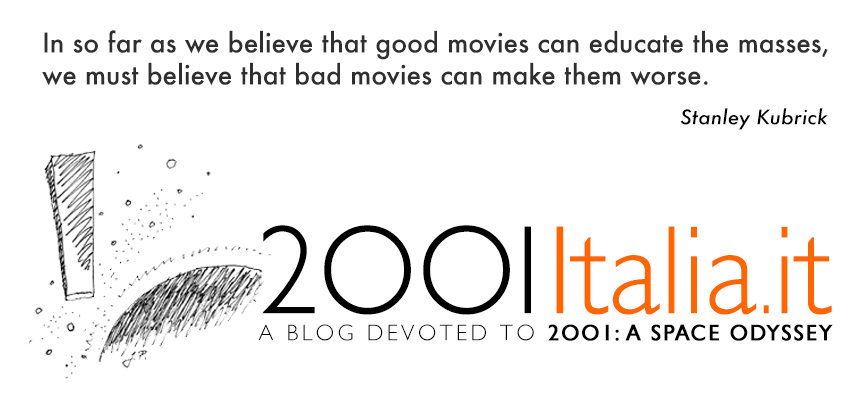fonte: catalogo della mostra "Stanley Kubrick", ed.tedesca, p.281
La storia che segue è solo un esempio di quello che potrete trovare nel clamoroso libro della Taschen The Making of Stanley Kubrick's 2OO1, uscito in edizione limitata il mese scorso e subito esaurito. E' però ancora disponibile un'altra versione, sebbene costosetta, che include anche una litografia autografa dell'artista Brian Sanders, quindi chi è interessato può ordinarlo dal sito medesimo o dai distributori italiani di libri.it.
Tali riprese richiesero una quantità senza precedenti di prove e sperimentazioni e durarono più di 18 mesi, principalmente poiché Kubrick era deciso ad un approccio "senza compromessi" per quanto riguardava l'aspetto dei modellini, in modo da rompere con il look non abbastanza verosimile che questi avevano finora avuto nel cinema di fantascienza. Il regista decise di esplorare ogni strada possibile, tra il tentativo di migliorare le tecniche di ripresa pre-esistenti e lo sviluppo di nuove metodologie.
Questo sforzo portò, per esempio, alla costruzione di un modello della Discovery lungo 16 metri (probabilmente ancor'oggi il modello di una nave spaziale più grande mai costruito per un film). Sarebbe stato impossibile, come si faceva usualmente, muovere il modellino attorno alla cinepresa: in questo caso era questa a muoversi attorno al modello, lungo una rotaia di una cinquantina di metri, per mezzo di un massiccio meccanismo a ruota dentata importato apposta da una fabbrica automobilistica di Detroit. Utilizzando questo meccanismo di precisione, facendo muovere lentissimamente la cinepresa ed impressionando solo pochi frame al secondo, con un'apertura ridottissima dell'obiettivo della macchina da presa, la squadra di effetti speciali capeggiata da Wally Veevers riuscì a ottenere una profondità di campo tale da avere la lunghissima Discovery a fuoco e nitidissima da un capo all'altro. Tale processo era talmente lento che venne descritto da Kubrick "come fissare la lancetta delle ore di un orologio".
Una rara immagine della Discovery lunga 16 metri. Kubrick aveva vietato di proposito fotografie di questo innovativo "modellone". Fonte: douglastrumbull.com
Lo stesso lentissimo metodo venne usato per girare la splendida sequenza in cui la stazione spaziale ruota attorno al proprio asse, con stupenda ed inarrivabile fluidità, nella scena in cui Floyd la raggiunge a bordo dell'Orion. Poiché per ottenere pochi minuti di filmato utile bisognava far muovere la macchina da presa per ore, non era ovviamente possibile accorgersi di problemi nel movimento dei modellini (per esempio oscillazioni o movimenti imprevisti degli stessi o della macchina da presa) se non dopo aver sviluppato la pellicola, cosa che a volte avveniva molto tempo dopo, e obbligava il già esausto team di effetti speciali a rigirare la scena.
Un giorno, controllando queste riprese risalenti a qualche settimana prima, Kubrick si accorse di un tremore evidente ed improvviso della stazione spaziale, che era sembrata letteralmente "sbandare da un lato all'altro dello schermo". Una veloce ricerca nei diari di produzione rivelò che quella particolare ripresa era stata effettuata nel pomeriggio del 30 Luglio. Cos'era successo?
Il modello della stazione spaziale aveva il diametro di quasi tre metri. Fonte: douglastrumbull.com
Molto semplicemente, la sequenza era stata girata esattamente durante la finale della Coppa del Mondo tra Inghilterra e Germania Ovest. Molti membri dello staff erano venuti a lavorare quel giorno solo a condizione di poter piazzare un televisore negli studi, in modo da poter dare un'occhiata di tanto in tanto... Allo stesso tempo, nello studio di ripresa di fianco, il modello della stazione spaziale ruotava lentamente, ripreso al ritmo di un fotogramma ogni sei secondi - e per soli diciotto secondi, vale a dire tre fotogrammi, a metà strada del girato, il pavimento aveva tremato. Verso le 17, tutti avevano saltato di gioia all'unisono - Geoff Hurst aveva segnato il gol vincente dell'Inghilterra!
Geoff Hurst segna il gol vincente della finale dei Mondiali: risultato finale, Inghilterra 4 Germania Ovest 2.
Il capitano inglese Bobby Moore con la Coppa Rimet (il trofeo che veniva assegnato all'epoca ai Campioni del Mondo, poi rimpiazzato dal 1974 dalla Coppa FIFA)
Citando di nuovo la figlia Katharina,
Mi ricordo che gli piaceva la squadra in cui giocava George Best - era il Manchester United? Era un grande fan di George Best. Ma non credo fosse "tifoso" di qualche squadra in particolare. Credo guardasse una partita quando le squadre giocavano bene, quando era un bello spettacolo da vedere - alcune partite sono noiose, e altre invece hanno giocatori interessanti.
Source: georgebest.com








